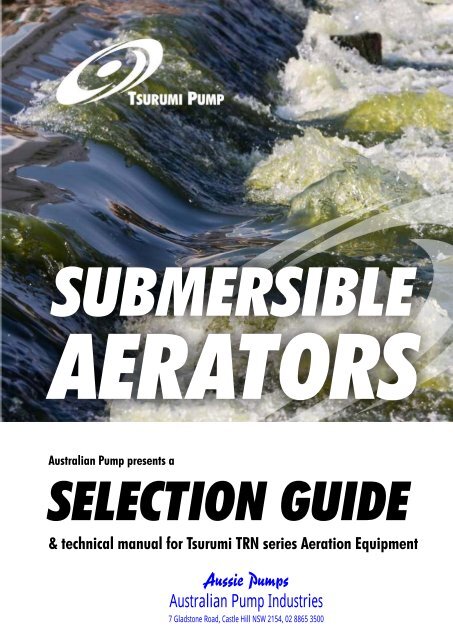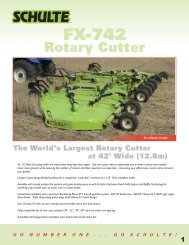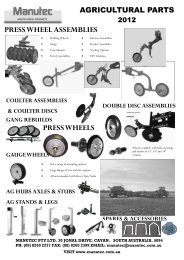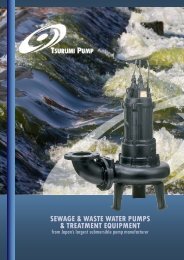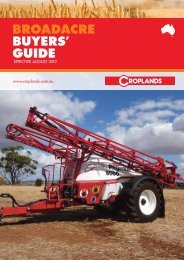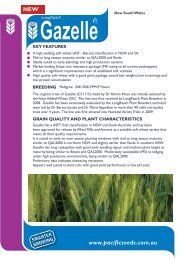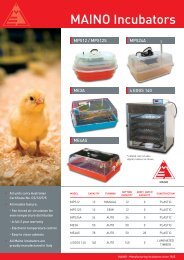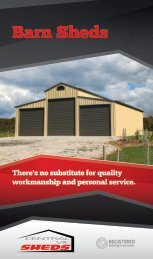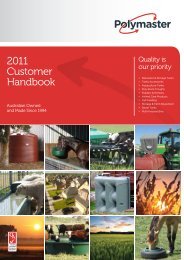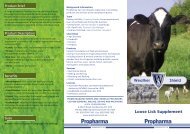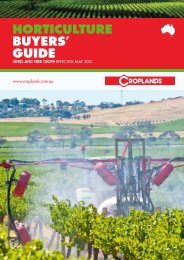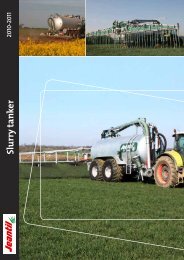Tsurumi Submersible Aeration (1846 Kb) - Ferret
Tsurumi Submersible Aeration (1846 Kb) - Ferret
Tsurumi Submersible Aeration (1846 Kb) - Ferret
Create successful ePaper yourself
Turn your PDF publications into a flip-book with our unique Google optimized e-Paper software.
■ 4-4. Notes to the Case that Two or More Aerators are to be installed in a Tank.If there is a need to install two or more aerators having the same output in a tank, decide the place of installationpaying attention to the distance between or among the aerators and the distance between the aerator and thetank’s sidewall. The distance between or among the aerators should be more than the “Main Convection Diameter”in the table of “4-3. Recommended Tank Dimensions (Standard)” on page 4. The distance between the aerator andthe sidewall should be so decided that the main convection might not hit directly on the sidewall.In addition, it shall be taken into account that the area to be convected by one aerator must be small than“Dimension of Sub-convection” in the same table.✳ If above-mentioned distances are smaller than the main convection, the aerator will suck the mixed air-watercurrent, and as a result it may lead to an unsteady operation of the aerator.✳ If the area convected by one aerator is bigger than the sub-convection of each aerator, the sufficiency mixingforce does not spread throughout the tank, and as a result it may allow the sludge to settle at the tank bottom.Main ConvectionMain ConvectionW.LDistance between the installed aerators should begreater than the main convection diameter.Main ConvectionCIRCULAR TANKMain ConvectionSQUARE TANKRECTANGULAR TANKMain Convection5Australian Pump Industries (02) 8865 3500
5. Aerator with Optional Stand or Draft TubeThere may be a need to install the aerator at a deeper position than its MWD, for example;· An aerator is going to be installed in an existing tank, and it is not possible to alter the depth of the tank, and· Because of the limited surface area, the tank must be designed to have a greater depth, etc.Adoption of a <strong>Tsurumi</strong> aerator with optional stand or draft tube (DT) will be one of the solutions for these cases. In case ofusing a stand, the mixing force at the bottom will be weakened as the inlet port of the aerator moves away from the bottom.Therefore, we have set the height limit on the stand of 0.5 meters, and for the cases of more than 0.5meters are required,we recommend an aerator with a DT. Note that the oxygen transfer rate and the air flow rate of the aerator shall be thosethat are obtainable at its self-aspiration water depth d [installation water depth h – (minus) height of stand or DT]. Inaddition, it shall be noted that the performance of the aerator with DT can be slightly lower than that of the standard.When there is a fear of overload occurring to the motor by due to a reason that it is going to operate in a viscous liquid, etc.,it will be possible to prevent the overload by reducing the self-aspiration water depth d with this method.The aerator may move or fall during operation by a reason that it is sitting on an irregular floor like slanted, bumpy, orslippery floor, or by a reason that it is installed in such that the weight of air-inlet piping acts on the aerator. Take anappropriate preventive measure in accordance with the conditions. In case that there is any flow generating equipment inthe tank, the same measure must be required.InstallationWater Depth hDischarge CurrentSelf-aspirationWater Depth d(Within MWD)DischargeCurrentDischarge CurrentSuction CurrentWithOptional Stand/ DTSuctionCurrentSuctionCurrentWith a stand of 0.5mImage of 0.75kW(Available 0.75kW to 40kW)With a DT of 1.0mImage of 5.5kW(Available 22kW to 40kW)With a DT of 1.5mImage of 40kW(Available 24kW to 40kW)■ 5-1. Recommended Tank Dimensions (with Stand or Draft Tube)AirinletBore[mm]325080with Stand (0.5m) Draft Tube (1.0m) Draft Tube (1.5m)Dimension ofSub-convectionDimension ofSub-convectionDimension ofSub-convectionModelMax Installation Circular Square Installation Circular Square Installation Circular SquareMotorWater Water Tank Tank Water Tank Tank Water Tank TankOutputDepth Depth h φa a Depth h φa a Depth h φa a[kW][m] [m] [m] [m] [m] [m] [m] [m] [m] [m]32TRN2.75-52/62 0.75 3.5 4 3.5 332TRN21.5-52/62 1.5 3.5 4 4 3.550TRN42.2-52/62 2.2 3.6 4.1 5.5 5 4.6 5 4.550TRN43.7-52/62 3.7 4 4.5 6.5 6 5 6 5.550TRN45.5-52/62 5.5 4 4.5 8.5 7.5 5 8 780TRN47.5-52/62 7.5 4.5 5 9.5 8.5 5.5 9 880TRN412-52/62 12 6 6.5 11.5 10.5 7 11 1080TRN417-52/62 17 6 6.5 12.5 11 7 12 10.5100 100TRN424-52/62 24 6 6.5 14 12.5 7 13.5 12 7.5 13 11.5150 150TRN440-52/62 40 6 6.5 16 14.5 7 15.5 13.5 7.5 15 13✳ Dimensions of each tank are those that have been determined under the condition that the self-aspiration water depth d equals tothe maximum water depth. These dimensions will vary depending on the installation water depth h.✳ It is recommended to provide a haunch between the bottom of the tank and every sidewall in order to maintain the mixing efficiency.✳ The aerator with a draft tube is not available in the shaded area.✳ The maximum water depth is the limit of installation depth that the aerator can run without overload. The motor load increases asthe installation depth becomes deeper, therefore, if the aerator is operated at a deeper position than this limit, the motor will beoverloaded, and then the motor protection device will operate, which makes it impossible to run continuously.✳ Refer to “4-1. Typical Convection Pattern” and “4-2. Shape of <strong>Aeration</strong> Tanks” on page 4 for the explanations on the tank shapeand the dimension.6Australian Pump Industries (02) 8865 3500
6. Oxygen Transfer RateThe oxygen transfer rate is the speed that the oxygen in the air dissolves into a liquid. It can be a guide when abiological treatment is going to be designed. The oxygen transfer rate is not the one that is directly measured. It isgiven from the calculations taking various factors such as DO concentration, ambient temperature, and watertemperature, etc. The oxygen transfer rate may vary by up to approximately 10%.The tables 6-1. below show the results of the tests that have been carried out on the TRN aerators in our test tank.It is suggested that these figures be used taking the above conditions into full consideration when selecting theaerators.The measurement of DO has been made by a Non-steady State method at the condition of fresh water, 20 o C, 1atm,with the dissolved oxygen of 0mg/l. The air flow rates are those of standard condition, 20 o C, 1atm. The aerator wastested under its standard installation; placed at the center of the tank and at the standard installation depth.■ 6–1. Oxygen Transfer Rate Test Result▼ 50HzAir-inletBore[mm]ModelMotorOutput[kW]InstallationWater Depth h(Standard)[m]Air Flow Rate[m 3 /h]OxygenTransfer Rate[kgO 2 /h]3232TRN2.75-52 0.75 3.5 7 0.632TRN21.5-52 1.5 3.5 20 1.150TRN42.2-52 2.2 3.6 39 2.450TRN43.7-52 3.7 4 55 4.2503 95 4.950TRN45.5-52 5.54 78 5.480TRN47.5-52 7.5 4.5 124 7.380 80TRN412-52 124 195 9.95 178 11.080TRN417-52 17 5 224 14.9100 100TRN424-52 24 5 400 20.2150 150TRN440-52 40 5 538 28.9Test TankPlaneDimension[m] x [m]Tank A( 5 x 5 )Tank B( 10 x 10 )▼ 60HzAir-inletBore[mm]ModelMotorOutput[kW]InstallationWater Depth h(Standard)[m]Air Flow Rate[m 3 /h]OxygenTransfer Rate[kgO 2 /h]3232TRN2.75-62 0.75 3.5 8 0.632TRN21.5-62 1.5 3.5 17 0.950TRN42.2-62 2.2 3.6 38 1.850 50TRN43.7-62 3.73 69 3.24 60 3.650TRN45.5-62 5.5 4 79 4.880TRN47.5-62 7.5 4.5 112 6.680 80TRN412-62 124 185 8.65 176 9.980TRN417-62 17 5 232 12.5100 100TRN424-62 24 5 368 17.9150 150TRN440-62 40 5 555 27.6Test TankPlaneDimension[m] x [m]Tank A( 5 x 5 )Tank B( 10 x 10 )7Australian Pump Industries (02) 8865 3500
■ 6-2. Oxygen Transfer Rate vs. Water Depth Curve - 50Hz * Calculated from the test result of Table 6-1.▼ The oxygen transfer rate may vary by up to approximately 10%. For the actual use, it may further vary dependingon the type of liquid and the shape of tank, so that select a suitable aerator having a certain margin.0.75kW and 1.5kW7.5kW to 17kW1.2161.032TRN21.5-521480TRN417-52Oxygen Transfer Rate [kgO 2 /h]0.80.60.40.20.032TRN2.75-520 1 2 3 4Water Depth [m]Oxygen Transfer Rate [kgO 2 /h]1210864280TRN412-5280TRN47.5-5201 2 3 4 5 6 7Water Depth [m]2.2kW to 5.5kW24kW and 40kW63550TRN45.5-52530150TRN440-52Oxygen Transfer Rate [kgO 2 /h]43250TRN43.7-5250TRN42.2-52Oxygen Transfer Rate [kgO 2/h]252015100TRN424-5211001 2 3 4 5Water Depth [m]52 3 4 5 6 7Water Depth [m]8Australian Pump Industries (02) 8865 3500
■ 6-3. Oxygen Transfer Rate vs. Water Depth Curve - 60Hz * Calculated from the test result of Table 6-1.▼ The oxygen transfer rate may vary by up to approximately 10%. For the actual use, it may further vary dependingon the type of liquid and the shape of tank, so that select a suitable aerator having a certain margin.0.75kW and 1.5kW7.5kW to 17kW1.2161.014Oxygen Transfer Rate [kgO2/h]0.80.60.40.20.032TRN21.5-6232TRN2.75-620 1 2 3 4Water Depth [m]Oxygen Transfer Rate [kgO 2/h]1210864280TRN417-6280TRN412-6280TRN47.5-6201 2 3 4 5 6 7Water Depth [m]2.2kW to 5.5kW24kW and 40kW635550TRN45.5-6230150TRN440-62Oxygen Transfer Rate [kgO2/h]43250TRN43.7-62Oxygen Transfer Rate [kgO2/h]252015100TRN424-62150TRN42.2-621001 2 3 4 5Water Depth [m]52 3 4 5 6 7Water Depth [m]9Australian Pump Industries (02) 8865 3500
7. Operation System■ 7-1. Reduced Speed Operation by Variable Frequency Drive (VFD)There are two methods in the adjustment of “air flow rate” and the “oxygen transfer rate” of the result. One is to squeeze the valvethat is installed in the air-inlet piping, and the other is to reduce the speed of aerator by VFD. However, the aerator has thecharacteristics described below, and different effects are expected.· The motor load increases as the installation depth becomes deeper.· The motor load increases as we reduce the air flow rate squeezing the valve that is installed in the air-inlet piping.In most cases, the adoption of reduced speed operation by VFD will enable us to regulate the air flow rate in a more extensive range thanoperating the valve, without sacrificing the efficiency. A comparison in the methods of adjustment is made in the following table. Refer tothis table in your planning.The graph of 7-1-2. shows comparisons in adjustment range between the two methods and 7-1-3. shows characteristics of reducedspeed operation by VFD for an aerator (Model 50TRN43.7-62) at 2 meters’ depth which has the widest possible range in the adjustmentof air flow rate.▼ 7-1-1. Comparisons in the Method of AdjustmentMethods forFeaturesAdjustment(○: shows the merit, ☓: shows the demerit)○ Installation will be completed by simply connection the valve at the inlet port of the air-inlet pipe.Adjustment ☓ Low power efficiency (kgO 2 / kWh) ⇒ Disadvantage in the energy savingby squeezing ☓ It is difficult to make an accurate control as the air flow rate and the operating current cannot be stabilized.the valve ☓ Louder beat☓ Narrow adjustment range at a deeper installationAdjustmentby reducingthe speedwith a VFD☓ It is necessary to install a VFD (extra initial cost is necessary).○ The power efficiency (kgO 2 / kWh) shall be maintained virtually constant.⇒ Energy saving operation with reduced power consumption is possible.○ The air flow rate and the running current can be maintained constant.⇒ Possible to control the air flow rate and the oxygen transfer rate accurately.○ Reduction of the operating frequency (reduction in air flow rate) will decrease the sound level.▼ 7-1-2. Comparisons in Adjustment Range (for reference only)“1” shows the adjustment range served by a VFD, and “2” shows it served by a valve.Estimated Air Flow Rate at the Standard Condition (20 o C, 1atm)Test Result at Our Test Tank (5m x 5m) with Clean Water, Converted to 20 o CAir Flow Rate [m 3 /h]▼ 7-1-3. Characteristics of Reduced Speed Operation by VFD (for reference only)Estimated Air Flow Rate at the Standard Condition (20 o C, 1atm)Air Flow Rate [m 3 /h]9080706050403020908070605040301Installation Water Depth2mDecreasein LoadInstallationWater Depth2 mIncreasein Load35 40 45 50 55 60 65Operation Frequency [Hz]InstallationWater Depth4 mInstallationWater Depth3 m2The motor will be overloadedif the valve is squeezed morethan this point.Oxygen Transfer Rate [kgO2/h]Test Result at Our Test Tank (5m x 5m) with Clean Water, Converted to 20 o COxyge Transfer Rate [kgO2/h]32.521.510.535 40 45 50 55 60 6543.532.521.511Installation Water Depth2mThe changing trend of the motor load isthe※sameモータas負left荷 のgraph.変 化 傾 向 は 左 図 と 同 じOperation Frequency [Hz]InstallationWater Depth4 mInstallationWater Depth2 m2The motor will be overloadedif the valve is squeezed morethan this point.InstallationWater Depth3 m2035 40 45 50 55 60 65Operation Frequency [Hz]100.535 40 45 50 55 60 65Australian Operation Pump Frequency Industries [Hz] (02) 8865 3500
■ 7-2. Operation in combination with BlowerThis is an operation system that an aerator and a general purpose blower are operated in conjunction. The blower isinstalled at the end of air-inlet line of an aerator and gives pressure to the air. This enables us to install the aeratorat a deeper position than the designed standard. For example, the aerator can be operated at the depth of 10 metersby means of the principle that the general purpose blower gives pressure to the air for 5 meters depth and theaerator sucks air for the 5 meters’ depth.▼ 7-2-1. Comparison against Other Deep <strong>Aeration</strong> Methods (in case the tank depth is 10m)<strong>Aeration</strong>Equipment<strong>Submersible</strong>Aerator(<strong>Tsurumi</strong>“TRN” series,self-aspirationtype)<strong>Submersible</strong>Aerator(Draft Tubetype axial-flowmixer)InstallationWaterDepth h[m]10OxygenTransferEfficiency(Clean Water)[%]26 to 53(Estimatedvalue)Pressure Lossby Equipment[kPa]0(because of theself-aspirationsystem)5 20 to 30 2.6 to 4.5Remarks(○: Merit, ☓: Demerit)○ High in the oxygentransfer efficiency asthe aerator canbe installed at the bottom.○ Possible to operatewith smaller powers(See p.14 7-2-5).○ Installation or maintenancework can be performedwithout draining the tank○ High-durability due to theoriginal “air-seal”structure andthe OIL LIFTER.☓ One (1) blower mustbe engaged toone (1) aerator only.○ Possible to reduce theequipment quantity as highin oxygen transfer rate.○ Anaerobic treatment ispossible.☓ Requiring the draft tube.☓ Expensive inpiping equipment.☓ Necessary to drain thetank in its first installation.AirsupplyPipeComponents Used(Summary)See p.12 7-2-2Equipment necessary for this OperationDraftTube<strong>Submersible</strong>Aerator(Draft Tubetypeaxial-flowmixer)InstallationWaterDepth h☓ Requiring the guide plate.Air-supply Pipe☓ Expensive inPlate Diffuser(Convection byline aerationmethod)5 15 to 173.92+ 0.29 to 0.78(aging increasein pressure loss)piping equipment.☓ Necessary to drainthe tank in its firstinstallation andInstallationWaterDepth hPlate DiffuserGuidePlatemaintenance.✳ A general purpose blower is supposed to be applicable to use up to 60 kPa.✳ The oxygen transfer efficiencies and the figure are quoted from “Guideline and Manual for Planning and Design in Sewerage Systems(2001)”.✳ When selecting a blower, calculate the required pressure including the loss of pressure which is generated in the piping system.11Australian Pump Industries (02) 8865 3500
▼ 7–2-2. Equipment necessary for this Operation· The blower must be operated with a VFD (Never use direct-on-line starting to start the blower.). Operationwith a VFD will be effective in energy saving.· One (1) blower must be engaged to one (1) aerator only. This is because, the air is transferred to the deeperarea of the tank by utilizing both the outlet pressure of the blower and the suction force of the aerator, and itis required to keep the balance between the two equipments. If the balance is disrupted, the aerator may idle(impeller runs in air) or may stop its operation by due to tripping of the motor protection device caused by anoverloading reason. As a result of these conditions, the blower gets into the “closed-valve” operation, whichcan cause the danger of a breakdown of the blower by the reason of overload or abnormal pressure.· Be sure to provide a non-return valve in the blower outlet piping. This is to prevent the treating liquid fromflowing back to the blower when the blower stops. Back-flow of the treating liquid pressurizes the air in thepiping, and this may cause the danger of a breakdown of the blower.· Provide a pressure gauge, which indicates the outlet pressure of the blower. This is required for operationadjustments.· When there is a need for the correct adjustment of air flow rate, provide a flow meter.· For other precautions, follow the instructions specified in each design manual.Blower HouseBlower(with VFD)Pressure GaugeNon-return ValveAir-inlet PipeW.LPressure depth coveredby the blowerInstallationWater Depth hSelf-aspiration water depth d bythe submersible aerator (within themaximum installation water depthof each aerator)<strong>Submersible</strong> Aerator12Australian Pump Industries (02) 8865 3500
▼ 7-2-3. Operation· Operation of the submersible aerator and the blower shall be controlled in such a manner that both equipmentbe started or stopped simultaneously.· Regulate the acceleration time (VFD) to approximately 10 seconds, and secure the stable starts of theseequipments. In case that the acceleration time is longer than this, the motor protection device of the aeratormay trip to stall the aerator by due to overload, and as a result the blower may have the danger of breakdowndue to overload or an abnormal pressure. In addition, the deceleration time (VFD) shall be regulated to theregion between 15 to 20 seconds so that the non-return valve may not suffer an impact.▼ 7-2-4. Adjusting Procedure for Air Flow Rate (e.g. 200V, 50Hz)Step 1. Prepare a clamp meter to measure the running current of the submersible aerator.Step 2. Regulate the rotating speed of the blower with VFD, according to the “Initially Targeted OperatingPoint of Blower” in the table of p.15 7-2-7.✳ Do not carry out this adjusting work by solely operating the blower. In case that the aerator is not operatingtogether, there may be the danger of breakdown of the blower by due to overload or abnormal pressure asthe blower gets into the “closed-valve” condition.Step 3. Start the submersible aerator and the blower simultaneously.Step 4. Confirm that the running current of the submersible aerator is within the limit of “Operating Range ofAerator on Running Current” described in the table of p.15 7-2-7. If not, rotating speed of the blower sothat the running current of the submersible aerator may fall within the operating range.✳ Method to decrease the running current of submersible aerator; Increase the rotating speed of the blower.By this, the self-aspiration water depth d of the submersible aerator becomes shallower and the runningcurrent will be decreased.✳ Method to increase the running current of submersible aerator; Decrease the rotating speed of the blower.By this, the self-aspiration water depth d of the submersible aerator becomes deeper and the runningcurrent will be increased.✳ If the running current of the aerator plunges much lower than the “Operating Range of Aerator on RunningCurrent”, it shows a symptom that the balance between the outlet pressure of the blower and the suctionforce of the aerator is disrupted, and that the aerator is not generating any suction force because it is idling.In this case, stop both of the blower and aerator immediately. If this condition continues, there will be thedanger of breakdown of the blower by due to overload or an abnormal pressure as the blower gets into the“closed-valve” operation.Step 5. Adjust the rotating speed of the blower with VFD in such a manner that the blower may discharge thetargeted air flow rate at its required pressure in a graph of 7-2-11. “Discharge Pressure of Blower vs. AirFlow Rate Curve (combination with blower – 50Hz)” on page 18.✳ Note that, depending on the operating condition, the blower could discharge the targeted air flow rate at apressure point lower than indicated in a graph of p.18 7-2-11. In this case, adjust the rotating speed of theblower assuming that it discharges maximum air flow rate on its graph at the point of minimum (running)current in the “Operating Range of Aerator on Running Current” in the table of p.15 7-2-7 and that itdischarges minimum air flow rate on its graph at the point of maximum (running) current in the range.13Australian Pump Industries (02) 8865 3500
▼ 7-2-5. Selection Procedure (Example)Condition - Water Depth of 10m, Required Oxygen Transfer Rate of 16.5kgO 2 /h (clean water), 200V, 50HzIn case of <strong>Submersible</strong> Aerator + General purpose BlowerProviding a safety factor of 10% for the required oxygen transfer rate, the required oxygen transfer rate shall be18.2kgO 2 /h.Refer to p.16 7-2-9. Oxygen Transfer Rate vs. Air Flow Rate Curve (combination with blower - 50Hz), and Model80TRN47.5-52 (7.5kW) can be selected. The required air flow rate shall be 180m 3 /h.Refer to p.18 7-2-11. Discharge Pressure of Blower vs. Air Flow Rate Curve (combination with blower - 50Hz,estimate). When the air flow rate required is 180m 3 /h (3.00m 3 /min), the required discharge pressure shall be0.053MPa (53kPa).In case that a margin of 5kPa is added to the discharge pressure of the blower (considering the pressure loss inthe pipe and a margin), the blower should have a duty of 53 + 5 = 58 kPa.Required air flow rate shall be 3.15m 3 /min. including 5% allowance. Model RSR-80 (1370min –1 , 3.20m 3 /min, at58.8kPa, 5.01kW) can be selected,The total required power is 〔7.5 + 5.01 = 12.51kW〕▼ 7-2-6. Recommended Tank Dimensions (combination with blower)BlowerDimension of Sub-convectionAir-inlet Bore[mm]5080ModelMotor Output[kW]50TRN42.2-52/62 2.250TRN43.7-52/62 3.750TRN45.5-52/62 5.580TRN47.5-52/62 7.580TRN412—52/62 1280TRN417-52/62 17100 100TRN424—52/62 24150 150TRN440—52/62 40Installation WaterDepth h[m]Discharge Pressure[kPa]6 248 449.6 606 208 4010 606 208 4010 606 208 4010 606 208 4010 606 208 4010 606 208 4010 606 208 4010 60Circular Tankφa[m]Square Tanka[m]6 5.57 6.59 810 912 1113 11.514.5 1317 15✳ The above table shows the estimated values under the condition that the self-aspiration water depth d (installationdepth h – Pressure depth covered by the blower) be 4 meters. The aerating depth of 2.2kW model is 3.6 meters. Forother operating conditions, refer to p.18 7-2-11. “Discharge pressure of Blower vs. Air Flow Rate Curve (combinationwith blower - 50Hz)”, or p.19 7-2-12. “Discharge pressure of Blower vs. Air Flow Rate Curve (combination withblower - 60Hz)”.✳ Discharge pressures in above do not include the pressure loss in the piping. It is required to calculate and add it to theabove value when selecting the blower.✳ It is recommended that a haunch be provided between each sidewall and the bottom of the tank so as to maintain themixing efficiency.✳ Only the above models are applicable to the combined use of an aerator and a blower.✳ Refer to “4-1. Typical Convection Pattern” and “4-2. Shape of <strong>Aeration</strong> Tanks” on page 4 for explanations on thetank shape and the dimension.14Australian Pump Industries (02) 8865 3500
▼ 7-2-7. Initially Targeted Operating Point of Blower andOperating Range of Aerator on Running Current (combination with blower - 50Hz)● 50HzModelMotorOutput[kW]50TRN42.2-52 2.250TRN43.7-52 3.750TRN45.5-52 5.580TRN47.5-52 7.580TRN412-52 1280TRN417-52 17100TRN424-52 24150TRN440-52 40InstallationWaterDepth h[m]Initially Targeted Operating Pointof BlowerDischarge Pressureof Blower[kPa]Inlet Air Flow Rateof Blower[m 3 /min]6 24 0.778 44 0.879.6 60 1.126 20 1.058 40 1.1810 60 1.506 20 1.508 40 1.6810 60 2.26 15 2.38 35 2.610 55 3.16 10 3.28 30 3.610 50 4.56 10 4.08 30 4.510 50 5.46 10 7.18 30 8.010 50 9.36 10 9.68 30 10.810 50 12.8Operating Range of Aeratoron Running Current(200V)[A](400V)[A]9.0 to 10.5 4.5 to 5.313.5 to 17.2 7.0 to 8.620.0 to 24.3 10.0 to 12.123.5 to 31.8 12.0 to 15.936.0 to 51.4 18.0 to 25.751.0 to 70.3 26.0 to 35.278 to 96 39 to 48134 to 165 67 to 83▼ 7-2-8. Initially Targeted Operating Point of Blower andOperating Range of Aerator on Running Current (combination with blower – 60Hz)● 60HzModelMotorOutput[kW]InstallationWaterDepth h[m]Initially Targeted Operating Pointof BlowerDischarge Pressureof Blower[kPa]Inlet Air Flow Rateof Blower[m 3 /min]Operating Range of Aeratoron Running Current6 24 0.7650TRN42.2-62 2.28 44 0.858.0 to 9.5 4.0 to 4.89.6 60 1.006 20 1.1350TRN43.7-62 3.78 40 1.3012.5 to 16.0 6.5 to 8.010 60 1.586 20 1.5050TRN45.5-62 5.58 40 1.7017.5 to 22.6 9.0 to 11.310 60 2.16 15 2.180TRN47.5-62 7.58 35 2.323.0 to 29.6 11.5 to 15.010 55 2.76 10 3.380TRN412-62 128 30 3.734.0 to 47.6 17.0 to 23.810 50 4.36 10 4.180TRN417-62 178 30 4.644.0 to 66.3 22.0 to 33.210 50 5.46 10 7.1100TRN424-62 248 30 7.480 to 96 40 to 4810 50 8.46 10 9.8150TRN440-62 408 30 11.1145 to 165 73 to 8310 50 13.0✳ The above tables are those that are to be utilized in p.13 7-2-4. “Adjusting Procedure for Air Flow Rate (e.g. 200V, 50Hz)”.✳ To adjust the air flow rate of the blower initially, set the VFD to regulate the blower speed to perform “Initially Targeted OperatingPoint of Blower”.✳ For the operation in combination with a blower, adjust the rotating speed of the blower so that the running current of thesubmersible aerator may fall within the “Operating Range of Aerator” stated above. If the running current of the aerator goesbeyond its range, the balance between the outlet pressure of the blower and the suction force of the aerator will be disrupted, andthe aerator will idle (impeller runs in air) or will stop its operation by due to tripping of the motor protection device caused by anoverloading reason. As a result of these conditions, the blower gets into the “closed-valve” operation, which can cause the dangerof breakdown of the blower by the reason of overload or abnormal pressure.(200V)[A](400V)[A]15Australian Pump Industries (02) 8865 3500
▼ 7-2-9. Oxygen Transfer Rate vs. Air Flow Rate Curve (combination with blower - 50Hz)* Calculated from 6-1 and 7-2-11● Data on this page are for reference only. It is suggested that a certain safety margin be added in your selection.Oxygen Transfer Rate [kgO2/h]950TRN42.2-52878mInstallation6Depth9.6m5436m220 30 40 50 60 70 80Air Flow Rate [m 3 /h]Oxygen Transfer Rate [kgO2/h]302520156m8m80TRN412-5210150 200 250 300 350Air Flow Rate [m 3 /h]InstallationDepth10mOxygen Transfer Rate [kgO2/h]161412108646m50TRN43.7-528m220 40 60 80 100 120 140Air Flow Rate [m 3 /h]InstallationDepth10mOxygen Transfer Rate [kgO2/h]4035302520158m80TRN417-526m10200 250 300 350 400 450Air Flow Rate [m 3 /h]InstallationDepth10mOxygen Transfer Rate [kgO2/h]201816141210868m50TRN45.5-526m460 80 100 120 140 160 180Air Flow Rate [m 3 /h]InstallationDepth10mOxygen Transfer Rate [kgO2/h]6050403020100TRN424-526m8m10300 400 500 600 700Air Flow Rate [m 3 /h]InstallationDepth10mOxygen Transfer Rate [kgO2/h]2220181614121086m8m80TRN47.5-526100 120 140 160 180 200 220 240Air Flow Rate [m 3 /h]InstallationDepth10mOxygen Transfer Rate [kgO2/h]807060504030208m6m150TRN440-5210500 600 700 800 900 1000Air Flow Rate[m 3 /h]InstallationDepth10m16Australian Pump Industries (02) 8865 3500
▼ 7-2-11. Discharge Pressure of Blower vs. Air Flow Rate Curve (combination with blower - 50Hz)Estimated Air Flow Rate at the Standard Condition (20 o C, 1atm)50TRN42.2-52 and 50TRN43.7-5280TRN412-52 and 80TRN417-52140420130400Air Flow Rate [m 3 /h]12011010090807060504030201050TRN43.7-52InstallationDepth6mInstallationDepth6m8m8m10m50TRN42.2-529.6mAir Flow Rate [m 3 /h]38036034032030028026024022020018080TRN417-52InstallationDepth6m8mInstallationDepth6m8m10m10m80TRN412-5200 0.02 0.04 0.06 0.081600 0.02 0.04 0.06 0.08Discharge Pressure of Blower [MPa]Discharge Pressure of Blower [MPa]50TRN45.5-52 and 80TRN47.5-52100TRN424-52 and 150TRN440-522401000Air Flow Rate [m 3 /h]220200180160140120100806080TRN47.5-52InstallationDepth6m8mInstallationDepth6m8m10m50TRN45.5-5210m0 0.02 0.04 0.06 0.08Air Flow Rate [m 3 /h]950900850800750700650600550500450400350300150TRN440-52InstallationDepth6m8mInstallationDepth6m8m10m10m100TRN424-520 0.02 0.04 0.06 0.08Discharge Pressure of Blower [MPa]Discharge Pressure of Blower [MPa]18Australian Pump Industries (02) 8865 3500
▼ 7-2-12. Discharge Pressure of Blower vs. Air Flow Rate Curve (combination with blower - 60Hz)Estimated Air Flow Rate at the Standard Condition (20 o C, 1atm)50TRN42.2-62 and 50TRN43.7-6280TRN412-62 and 80TRN417-62140420130400Air Flow Rate [m 3 /h]12011010090807060504030201050TRN43.7-62InstallationDepth6mInstallationDepth6m8m10m9.6m8m50TRN42.2-62Air Flow Rate [m 3 /h]380360340320300280260240220200180InstallationDepth6m80TRN417-628mInstallationDepth6m8m10m10m80TRN412-6200 0.02 0.04 0.06 0.081600 0.02 0.04 0.06 0.08Discharge Pressure of Blower [MPa]Dicharge Pressure of Blower [MPa]50TRN45.5-62 and 80TRN47.5-62100TRN424-62 and 150TRN440-622401000220950900200850150TRN440-6210mAir Flow Rate [m 3 /h]18016014012080TRN47.5-62InstallationDepth6m8m10m10mAir Flow Rate [m 3 /h]800750700650600550500InstallationDepth6m8m10m1008060InstallationDepth6m8m50TRN45.5-620 0.02 0.04 0.06 0.08450400350300InstallationDepth6m8m100TRN424-620 0.02 0.04 0.06 0.08Discharge Pressure of Blower [MPa]Discarge Pressure of Blower [MPa]19Australian Pump Industries (02) 8865 3500
8. About NoiseSuction noise will be generated at the suction silencer while the gas to be handled is being sucked by the submersibleaerator. “8-2. Measured Sound Pressure Level Data” shows the sound pressure level of each aerator. Note thatthese sound pressure level data are those measured at an indoor test facility in our factory and are not theguaranteed figures that are expected at your site. Also note that the sound pressure level may vary depending onvarious factors like piping condition.■ 8-1. Measured Point and ConditionFactory StructureSilencer1mSound Level Meter1.6mAir-inlet Piping(PVC Flexible Hose, 10m)W.L<strong>Submersible</strong>Aerator■ 8-2. Measured Sound Pressure Level DataAir-inlet Bore[mm]325080ModelMotor Output[kW]32TRN2.75 0.7532TRN21.5 1.550TRN42.2 2.250TRN43.7 3.750TRN45.5 5.580TRN47.5 7.580TRN412 1280TRN417 17100 100TRN424 24150 150TRN440 401m from theSilencerA-weightedInstallationSound PressureWater Depth h[m]Level[dB(A)]1.5 533.5 541.5 533.5 582.5 613.6 612 664 702 694 702 714.5 683 726 733 746 724.5 736 743.5 706 74The Inside of theFactory StructureBack GroundNoise Level[dB(A)]43434343434242454549✳ Measurements of the sound pressure level have been carried out in accordance with JIS B 8346-1991, “Fans, Blowers andCompressors - Determination of A-weighted Sound Pressure Level”.✳ The equipment used for the measurement was a standard sound level meter that complies with JIS C 1502.✳ Frequency correction “A” and “SLOW” time weighting were used for the sound level meter.✳ The sound pressure level data are those that have been calculated from the average sound pressure levels measured atfour (4) points, all of which are located at the same height of 1.6m from the floor but are equally distributed to four-way tothe distance of 1m away from the silencer.20Australian Pump Industries (02) 8865 3500
TRN <strong>Submersible</strong> AeratorThe TRN is designed for very high oxygen transfer efficiency and to mix entrained solids., Non-clog impellers., Horsepower ranges from 1 hp to 50 hp., Can operate in water depth of 32 feet with supplemental blower., Powerful stirring and mixing capabilities for convectional circulation., Compact shape and design., Self aspiration of oxygen eliminates need for compressed air.KE & KM Bar ScreensMechanically cleaned bar screens; designed for the small plant inflows toremove solids from the wastewater, eliminating solids from aeration &Clarification tanks. Screen capacity range from 1 GPM to 690 GPM. Barspacing range from 1mm to 50mm. Screen is fabricate in 304 stainless steel forcorrosion resistance.TRN, FHP, KE & KM SERIESAPPLICATION, Primary treatment at a factory wastewater treatment plant, Screening suspended solid from kitchen effluent at hotel, factory, hospital, etc., Screening suspended solid from wastewater at small scale wastewater facilityThe KE/KS SERIES are front-type mechanical bar screens in which major parts are made of 304stainless steel. The saw teeth on each rake travel between screen bars, which prevents foreignmatters from lodging in the screen bars. The KS-series has an eccentric roller mechanism that pullsthe rake out of the screen bars at the solids releasing point and eliminates the jamming of solids.The KM/KMA SERIES are rear-type mechanical bar screens in which major parts are made of 304stainless steel. The chain and sprocket do not come in contact with the liquid that prevents stickingof solids to the rotating parts. Being a self-standing design, it can be directly installed to a U-shaped waterway.FHP Series decanting pumpThe FHP-series is a decanting pump with a device for monitoring the sludge surface. The pumpensures that only supernatant liquid is discharged, without any sediment.DischargeBore (mm)ModelMotorOutput KWFSP Series skimmer pumpPhaseStartingMethodDry Weight kgFREE STANDINGHead Max.mCapacity max./min40 FHP2-3 0.25 Capacitor 29.5 8 200 640 FHP2-3T 0.25 Capacitor 27.5 8 200 650 FHP-4 0.4 single Capacitor 29 10 280 650 FHP-4T 0.4 3-phase d.o.l. 27 10 280 650 FHP3-8T 0.75 3-phase d.o.l. 27.5 13 420 680 FHP2-15T 1.5 3-phase d.o.l. 60 11 800 6CablelengthmThe FSP-series is a scum skimmer incorporating a jet injector. It guarantees a stable sucking processeven if water, air, and suspended matter are drawn in from water surface simultaneously.DischargeBore (mm)ModelMotorOutputKWPhaseStartingMethodSpeedp 11Max. SolidHandlingmmCablelengthm50 4-FSP 0.4 3-phase d.o.l. 3000 16 650 8-FSP 0.75 3-phase d.o.l. 3000 22 6Pump selection software available … Australian Pump 02 8865 3500
Equipment Selection GuideSewage/wastewater pumpsEffluentPumpsType Model Discharge bore mm Motor Output kW FeatureCorrosionresistantExplosion proofCorrosionresistantB 50-800 0.4-110 Basic sewage pumpBZ 80-100 1.5-15 Basic sewage pump with large solid passageC 50-100 0.75-15 Basic sewage pump with cutter mechanismU 40-80 0.25-3.7 Vortex sewage pump with 2 pole motorUZ 50-100 1.5-11 Vortex sewage pump with large solid passageUT 50 0.4 Vortex sewage pump with single phase motorPU 40-80 0.15-1.5 Vortex sewage pump - resinPN 40-50 0.25-1.5 Semi-vortex wastewater pump - resinMG 32-50 1-3.7 High head grinder pumpBQ 50-100 0.4-3.7 Cast ss version of B seriesCQ 50-100 0.75-3.7 Cast ss version of C seriesBX 80-100 1.6-3.8 Explosion proof version of B seriesCX 80-100 1.6-3.8 Explosion proof version of C seriesUX 50-80 1.6-4 Explosion proof version of U seriesPSF 40-50 0.25-1.5 High head effluent pump - resinSF 50-80 0.75-11 Semi-open impeller, for high head pumpingOM 32 0.15 Semi-vortex effluent pump - resinSQ 40-50 0.25-0.75 Lightweight ss effluent pumpSFQ 50-80 0.4-11 Chemical effluent pump - cast ssTM 40-50 0.25-0.75 Seawater pump - titanium & resinBlower RS 20-150 0.4-45 Rotary air blowerTRN 32-150 0.75-40 <strong>Submersible</strong> self aspirating aeratorAeratorWaterBER 25-50 0.75-5.5 <strong>Submersible</strong> axial-flow type aeratorTreatment Skimmer FSP 50 0.4-0.75 Floating scum skimmerEquipment Decanting pump FHP 40-80 0.25-1.5 Float type decanting pumpBar ScreenKE/KS - - Automatic mechanical bar screen (front)KM/KMA - - Automatic mechanical bar screen (rear)Dewatering pump range also available … contact Aussie Pumps for more detailsAustralian Pump Industries Pty Ltd7 Gladstone Road, Castle Hill NSW 2154Ph: (02) 8865 3500 Fax: (02) 9894 4240www.aussiepumps.com.auinfo@aussiepumps.com.au


